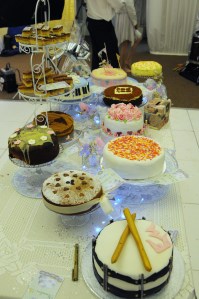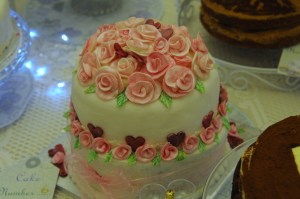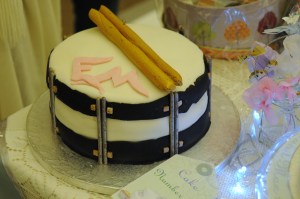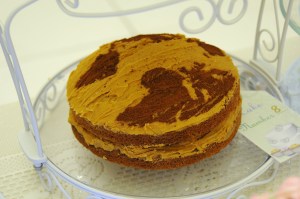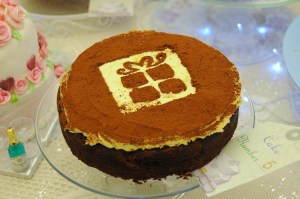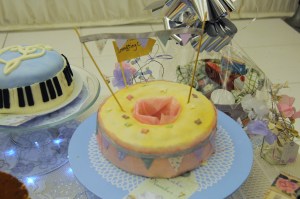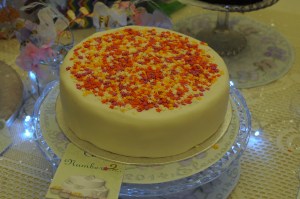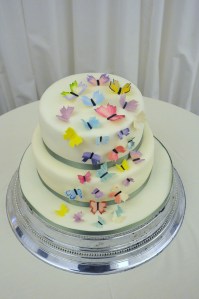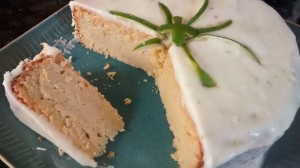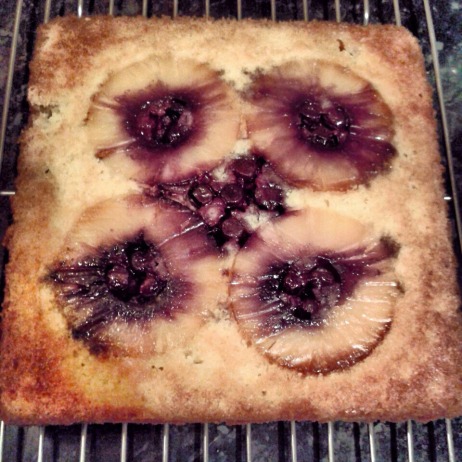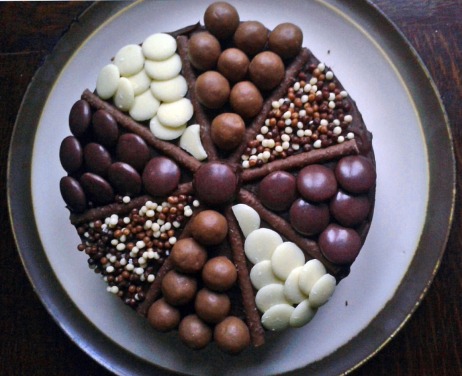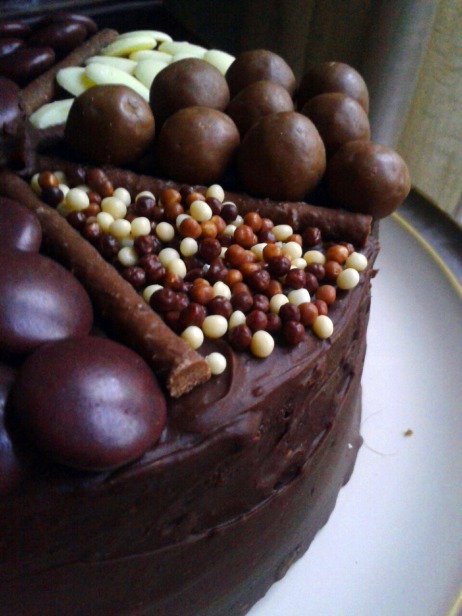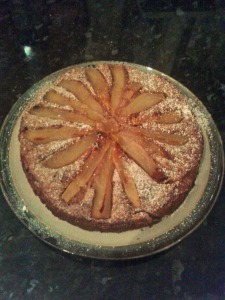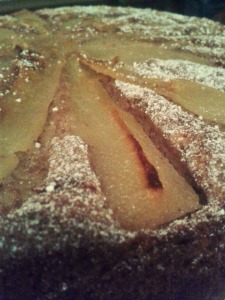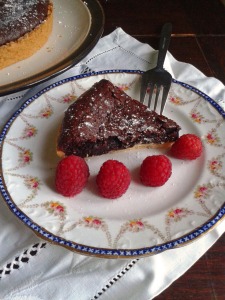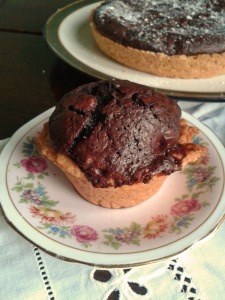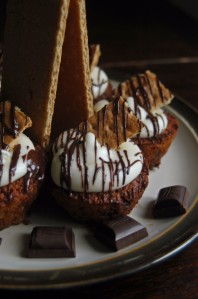
France is known throughout the world for its patisserie, with some of the most famous desserts originating from this culture. Macarons, gateaux, eclairs – the list goes on. As a consequence I was really spoilt for choice when designing this cake. I settled on tarte tatin eventually though an artistic point rather than an edible one – I loved the idea of trying to create the decoration out of he top of the cake itself, rather than covering it with other things, as is so often the case.
This cake is a variation on an upside-down cake, a design of cake which is seen as ‘retro’ these days. The bottom of the cake tin is covered with caramel, and the apples are arranged in a flower pattern on the top of this. the cake mix is then placed on top of this and the whole cake is then baked in the oven. A second cake contains a layer of pastry cooked on top of the cake, much like a Bakewell tart. The two cakes are then sandwiched together with caramel creme patisserie, and the finished cake is decorated with sugar decorations.
This cake involves a significant amount of work with hot sugar and caramel so care must be taken. You must not use a springform tin to make the cake as the hot caramel may leak through the joins, causing danger of burns. For your safety, ensure that you use a solid, well greased tin and that you use oven gloves and great care!
Ingredients:
Cake:
- 225g (8oz) salted butter
- 225g (8oz) golden caster sugar
- 225g (8oz) self-raising flour
- 1/2 tsp bicarbonate of soda
- 4 eggs
- 60ml (4 tbsp) whole milk
- 1/2 tsp vanilla extract
Toffee apple topping:
- Butter (for greasing)
- 200g (7oz) caster sugar
- 3 large Grany Smith apples, peeled, cored and sliced into 1cm slices
- Zest of one large orange
Pastry Disc:
- 250g plain flour
- 50g icing sugar
- 125g butter, cut into small cubes
- Zest of one orange
- 1 large egg, beaten
- 1 splash of milk
Caramel Crème Patisserie:
- 6oz sugar
- ¼ cup water
- 2 cups milk
- 1 ¼ ounce cornstarch
- 1 large egg
- 2 large egg yolks
- ½ ounce unsalted butter
- 1 teaspoon vanilla extract
Salted Caramel Shards
- 1 cup caster sugar
- 1/8 cup water
- 2 pinches sea salt
Instructions:
Preheat the oven to 180˚C/350˚F/Gas Mark 4. Grease and line a 9 inch baking tin and set aside.
Heat the sugar and 3 tbsp water in a pan over a high heat until the sugar has dissolved and turned a rich golden brown colour. Do not stir this at any point, as the sugar will crystallise. Remove from the heat and pour into the lined baking tin, ensuring that the base is completely covered. Arrange the apple wedges on the top and cover with a third of the orange zest.
Make the cake by beating the butter, sugar and the rest of the orange zest until fluffy and pale yellow in colour. Mix in the eggs on at a time, before sifting in the flour and bicarbonate of soda. Add the milk and vanilla extract and stir well to combine.
Pour the mixture into the cake tin and bake for 40-50 minutes until an inserted skewer comes out clean. Place a cooling rack over the top of the tin and invert, being careful to avoid any caramel that may fall out. Remove from the tin and set aside to cool completely
To make the pastry disc, sieve the flour and icing sugar into a bowl. Using your fingers, work the cubes of butter into the mixture until it resembles fine breadcrumbs. Mix in the orange zest. Add the eggs and milk, and mix to form a soft dough. Lightly flour this dough.
Pat the mixture into a thick disc and flour it. Wrap it in cling film and refrigerate for 30 minutes.
Roll out the dough on a floured surface to approximately 5mm thick. Cut the dough to the same size as the cake, and place in the cake tin to ensure an accurate base. Prick all over with a fork and add baking beans to the case to ensure that the pastry does not rise up. Bake in the oven at 180˚C/Gas Mark 4 for about 15-20 minutes, checking constantly to ensure it doesn’t burn.
Remove from the oven and leave to cool for 10 minutes. Remove the pastry circle from the tin and leave to cool on a baking rack.
Combine 5 ounces of the sugar and the water in a small, heavy saucepan. Bring to a boil, brush down the sides of the pan with water, and boil for 8 to 10 minutes, or until caramelized. The sugar will be fragrant and a deep amber color when it is caramelized. Remove the pan from the heat and dip the bottom into an ice water bath for a second or two. Slowly stir in the milk. Return the pan to low heat and stir until smooth. Increase the heat to medium and heat to a simmer.
Meanwhile, whisk together the cornstarch and remaining 1 ounce of sugar in a medium bowl. Whisk in the egg and yolks. Continue whisking while adding the hot caramel mixture in a thin stream. Transfer the mixture back to the saucepan and cook, whisking constantly, over medium heat for 2 to 3 minutes, or until it thickens and just comes to a boil. Immediately strain through a fine mesh sieve into a clean bowl and stir in the butter and vanilla. Press plastic wrap directly onto the surface and refrigerate.
To make the caramel shards, put the water and sugar in a small saucepan and heat up. don’t stir, but swirl the pan occasionally. Allow the sugar to gently caramelise before quickly pouring onto a lined and greased baking sheet. quickly tip the sheet to ensure complete coverage, and sprinkle with sea salt. allow to cool completely before breaking into shards.
Assemble the cake by placing the pastry circle on the serving plate and covering with a layer of caramel crème patisserie. carefully place the cake on top, and decorate with caramel shards.





